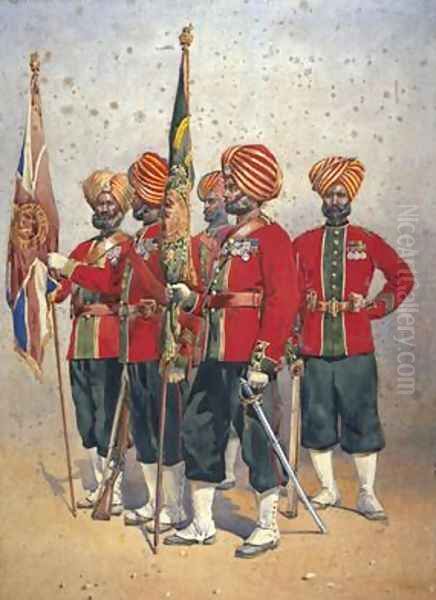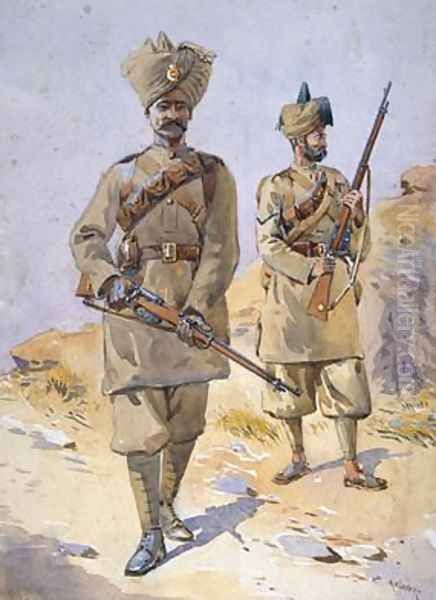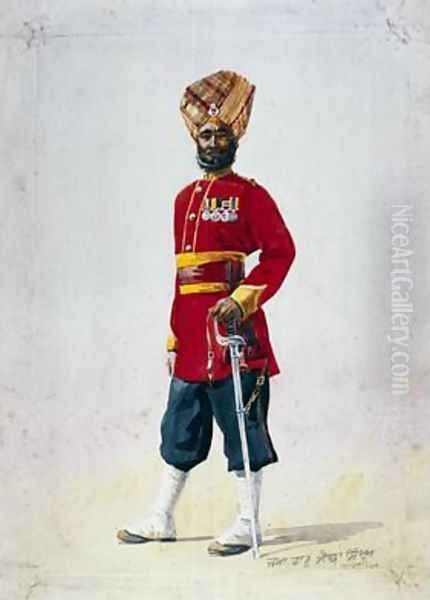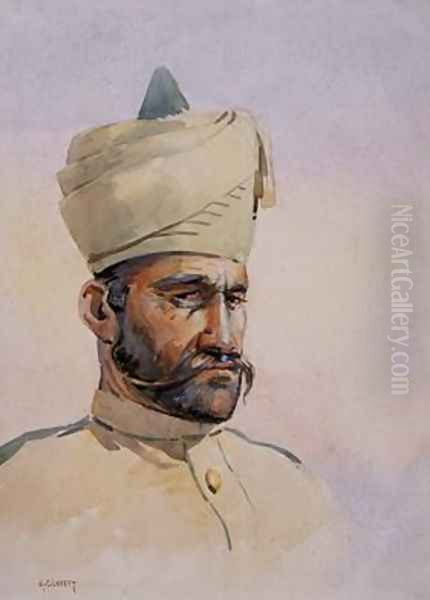Alfred Crowdy Lovett stands as a notable, if sometimes overlooked, figure in the annals of British military art. Working primarily in the late 19th and early 20th centuries, Lovett dedicated his artistic endeavors to capturing the diverse and vibrant tapestry of the British Indian Army. His medium of choice was watercolour, a demanding yet expressive form that, in his hands, lent itself to detailed and evocative portrayals of soldiers, officers, and the ceremonial grandeur associated with colonial India. His work serves not only as an artistic record but also as an invaluable historical document, offering insights into the uniforms, traditions, and personalities of a pivotal era.
The Artist in Context: Imperial India and Military Art
To understand Alfred Crowdy Lovett's contribution, one must first appreciate the backdrop against which he worked: the British Raj. This period saw an immense interest in the "exotic" East, and India, the "jewel in the crown" of the British Empire, was a source of endless fascination. The Indian Army, a formidable force composed of numerous distinct regiments drawn from various ethnic and religious groups, was a subject of particular pride and interest, both within India and back in Britain. Artists played a crucial role in visualizing this empire for a wider audience.
The tradition of military art was well-established in Britain by Lovett's time. Artists like Lady Elizabeth Butler, with her dramatic and often poignant depictions of British soldiers in battle (e.g., "The Roll Call," "Scotland Forever!"), had already captured the public imagination. Richard Caton Woodville Jr. was another prolific illustrator and painter of military scenes, often for publications like the Illustrated London News, bringing contemporary conflicts and colonial expeditions to life for the British public. Lovett's work, however, tended to focus less on the heat of battle and more on the meticulous depiction of military personnel, their attire, and their distinct regimental identities.
A Focus on Detail: Lovett's Watercolour Technique

Lovett's proficiency in watercolour allowed him to render the intricate details of military uniforms with remarkable precision. From the vibrant colours of turbans and sashes to the polished gleam of medals and weaponry, his paintings are characterized by a careful attention to accuracy. This was essential, as military uniforms of the period were not merely functional attire but also potent symbols of regimental pride, history, and imperial authority. His works often have a documentary quality, suggesting a deep understanding of and respect for his subjects.
The choice of watercolour itself is significant. While oil painting was often reserved for grand historical canvases or formal portraiture, watercolour was a more portable and immediate medium, well-suited for an artist potentially working in diverse locations or needing to capture fleeting details. Artists like J.M.W. Turner had already elevated watercolour to a high art form in Britain, demonstrating its capacity for both atmospheric effects and precise rendering. Lovett's application seems to lean towards the latter, prioritizing clarity and informational content, which makes his work particularly valuable for uniformologists and military historians.
Representative Works: Portraits of an Army
Several key works exemplify Alfred Crowdy Lovett's artistic output and thematic concerns. Among these are his portraits of distinguished Indian officers and rulers who held honorary positions within the Indian Army.
One such notable piece is "Colonel His Highness Maharaja Sir Ganga Singh, Bahadur, of Bikaner," created around 1911. Maharaja Ganga Singh was a progressive ruler and a respected military figure, and Lovett’s depiction would have aimed to capture his regal bearing and military distinction. Such portraits were not merely personal likenesses; they also served to highlight the loyalty and martial prowess of India's princely states within the imperial framework. The detail in the uniform, the decorations, and the overall posture would have been paramount.
Another significant work is "Honorary Major His Highness Maharao Umed Singh Bahadur of Kota," dated circa 1908. Similar to the portrait of Ganga Singh, this piece would have emphasized the Maharao's status and his connection to the military establishment. These depictions of Indian princes in British Indian Army uniforms underscored the complex alliances and hierarchies of the Raj. Lovett’s skill would have been employed to convey both the individual's character and the symbolic weight of his attire.

Beyond individual portraits of high-ranking figures, Lovett also produced broader studies of Indian soldiers. A work simply titled "Indian Soldiers," from around 1910, showcases his ability to depict various regimental types. During this period, the Indian Army was a mosaic of different communities – Sikhs, Gurkhas, Rajputs, Pathans, Dogras, and many others – each with distinct traditions, and often, variations in their uniforms or accoutrements. Lovett's watercolours would have carefully delineated these differences, perhaps showing soldiers in their review order or field service kits, sometimes highlighting the transition to khaki which was becoming widespread.
Collaboration and Publication: "The Armies of India"
A significant aspect of Lovett's career was his work as an illustrator for publications focusing on military subjects. His watercolours were notably used in the book "The Armies of India," authored by Major (later Lieutenant-General Sir) George Fletcher MacMunn and published by A & C Black in 1911. This volume was a comprehensive survey of the various components of the Indian Army, and Lovett's illustrations were integral to its appeal and informational value.
Working in collaboration with an author like MacMunn, who was himself a knowledgeable military officer, would have ensured a high degree of accuracy in Lovett's depictions. The plates in "The Armies of India" provided a visual encyclopedia of the soldiers of the Raj, from the cavalry sowar in his brilliant lungi to the infantry sepoy in his meticulously tied turban. These illustrations reached a wide audience and helped to shape perceptions of the Indian Army. This kind of illustrative work was common for artists of the period; Mortimer Menpes, for example, an Australian-born artist, also produced books with his own illustrations based on his travels, including to India, capturing everyday life and ceremonial events with a distinct artistic style.
The Artist's Eye: Observing Culture and Character
While the primary focus of Lovett's work was military, his detailed renderings inevitably touched upon broader cultural aspects. The depiction of a Sikh soldier, for instance, would necessitate careful attention to the articles of faith, such as the turban and beard. Similarly, portraying a Gurkha would involve capturing their distinctive features and perhaps the iconic kukri. This attention to ethnographic detail, filtered through a military lens, adds another layer to his work.

It is said that Lovett's works are "characterized by meticulous depiction and attention to detail, demonstrating his profound understanding of Indian culture." This suggests an artist who was not merely a draftsman of uniforms but an observer of the men who wore them. While the colonial context is undeniable, and the gaze is inherently that of a British artist, there is often a sense of dignity and individuality in his figures. This contrasts with some Orientalist painters like Jean-Léon Gérôme, whose depictions of the East, while technically brilliant, sometimes veered into exoticized stereotypes. Lovett's work, by its nature, was more grounded in the specific realities of the Indian military establishment.
Lovett in the Wider Artistic Landscape
Placing Lovett within the broader art world of his time requires considering various contemporaries. In Britain, the art scene was diverse. The Pre-Raphaelites like Dante Gabriel Rossetti or John Everett Millais had left a lasting legacy, and new movements were emerging. However, Lovett's work aligns more closely with a tradition of representational art focused on specific subject matter.
Artists like Edwin Lord Weeks, an American, spent considerable time in India and produced large, detailed oil paintings of Indian scenes, often with a focus on architecture and grand processions. While Weeks worked on a different scale and often with more overtly "Orientalist" themes, there's a shared interest in the visual richness of India. Another contemporary, Vasily Vereshchagin, a Russian war artist, also painted in India, producing powerful and sometimes critical depictions of both colonial rule and Indian life, such as his "Blowing from Guns in British India." Vereshchagin’s work often carried a strong anti-war message, a different emphasis than Lovett's more documentary focus on military personnel.
In terms of portraiture, Lovett's work can be seen as a specialized subset. While John Singer Sargent was creating dazzling society portraits in London and Paris, capturing the elegance and psychology of the Edwardian elite, Lovett was applying his skills to a different kind of subject, where the uniform and its symbolism were as important as the individual likeness. Frank Salisbury, another British artist, was known for his royal portraits and large ceremonial pieces, sharing with Lovett an interest in depicting figures of authority and occasions of state, albeit in a different social sphere.
The tradition of recording military life and far-flung parts of the Empire also included artists like William Simpson, who had earlier served as a war artist in the Crimean War and later travelled extensively in India, documenting its landscapes, architecture, and people. His work, often in watercolour, had a strong topographical and ethnographic element.
The Enduring Value of Lovett's Art

The historical significance of Alfred Crowdy Lovett's art cannot be overstated. In an era before widespread colour photography, his watercolours provided a vivid and accurate record of the men who formed the backbone of British military power in India. These images are invaluable for researchers studying:
Military Uniforms and Equipment: The precision of his work is a primary source for understanding the evolution of uniforms, accoutrements, and regimental distinctions.
Colonial History: His art offers a visual perspective on the structure and composition of the Indian Army, reflecting the complex interplay of British imperial policy and Indian martial traditions.
Cultural Representation: While viewed through a colonial lens, his depictions offer glimpses into the diverse ethnic and religious groups that contributed to the army.
His paintings are more than just illustrations; they are historical artifacts that capture a specific moment in time. They document an army that was unique in its composition and character, an army that played a significant role in global conflicts, including the First and Second World Wars. Artists like Frederic Remington and Charles Marion Russell were doing similar work in the American West, documenting the lives of cowboys, Native Americans, and the U.S. Cavalry, preserving a rapidly changing frontier. Lovett performed a similar service for the Indian Army of his day.
While details about Alfred Crowdy Lovett's personal life, such as his precise birth and death dates or locations, are not always readily available in common art historical summaries, his artistic legacy is clear. His body of work, particularly the illustrations for "The Armies of India" and individual portraits, ensures his place as a significant chronicler of military life during the British Raj. His dedication to accuracy and his skill in the watercolour medium have left behind a legacy that continues to inform and fascinate. He may not have sought the avant-garde paths of contemporaries like Paul Cézanne or the burgeoning Impressionists like Claude Monet or Edgar Degas, who were revolutionizing European art, but within his chosen field, Lovett excelled, providing a window into a world that has long since vanished. His art remains a testament to the soldiers he depicted and the era he so meticulously recorded.